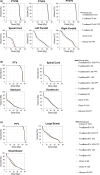Reducing variability among treatment machines using knowledge-based planning for head and neck, pancreatic, and rectal cancer
- PMID: 34151503
- PMCID: PMC8292706
- DOI: 10.1002/acm2.13316
Reducing variability among treatment machines using knowledge-based planning for head and neck, pancreatic, and rectal cancer
Abstract
Purpose: This study aimed to assess dosimetric indices of RapidPlan model-based plans for different energies (6, 8, 10, and 15 MV; 6- and 10-MV flattening filter-free), multileaf collimator (MLC) types (Millennium 120, High Definition 120, dual-layer MLC), and disease sites (head and neck, pancreatic, and rectal cancer) and compare these parameters with those of clinical plans.
Methods: RapidPlan models in the Eclipse version 15.6 were used with the data of 28, 42, and 20 patients with head and neck, pancreatic, and rectal cancer, respectively. RapidPlan models of head and neck, pancreatic, and rectal cancer were created for TrueBeam STx (High Definition 120) with 6 MV, TrueBeam STx with 10-MV flattening filter-free, and Clinac iX (Millennium 120) with 15 MV, respectively. The models were used to create volumetric-modulated arc therapy plans for a 10-patient test dataset using all energy and MLC types at all disease sites. The Holm test was used to compare multiple dosimetric indices in different treatment machines and energy types.
Results: The dosimetric indices for planning target volume and organs at risk in RapidPlan model-based plans were comparable to those in the clinical plan. Furthermore, no dose difference was observed among the RapidPlan models. The variability among RapidPlan models was consistent regardless of the treatment machines, MLC types, and energy.
Conclusions: Dosimetric indices of RapidPlan model-based plans appear to be comparable to the ones based on clinical plans regardless of energies, MLC types, and disease sites. The results suggest that the RapidPlan model can generate treatment plans independent of the type of treatment machine.
Keywords: different treatment machine; disease site; energy; knowledge-based planning; multileaf collimator type.
© 2021 The Authors. Journal of Applied Clinical Medical Physics published by Wiley Periodicals LLC on behalf of American Association of Physicists in Medicine.
Figures



Similar articles
-
Fully automated searching for the optimal VMAT jaw settings based on Eclipse Scripting Application Programming Interface (ESAPI) and RapidPlan knowledge-based planning.J Appl Clin Med Phys. 2018 May;19(3):177-182. doi: 10.1002/acm2.12313. Epub 2018 Mar 25. J Appl Clin Med Phys. 2018. PMID: 29577614 Free PMC article.
-
A dosimetric evaluation of knowledge-based VMAT planning with simultaneous integrated boosting for rectal cancer patients.J Appl Clin Med Phys. 2016 Nov 8;17(6):78-85. doi: 10.1120/jacmp.v17i6.6410. J Appl Clin Med Phys. 2016. PMID: 27929483 Free PMC article.
-
Impact of nominal photon energies on normal tissue sparing in knowledge-based radiotherapy treatment planning for rectal cancer patients.PLoS One. 2019 Mar 7;14(3):e0213271. doi: 10.1371/journal.pone.0213271. eCollection 2019. PLoS One. 2019. PMID: 30845263 Free PMC article.
-
Photon Optimizer (PO) prevails over Progressive Resolution Optimizer (PRO) for VMAT planning with or without knowledge-based solution.J Appl Clin Med Phys. 2017 Mar;18(2):9-14. doi: 10.1002/acm2.12038. Epub 2017 Jan 24. J Appl Clin Med Phys. 2017. PMID: 28300375 Free PMC article.
-
Critical Appraisal of the Treatment Planning Performance of Volumetric Modulated Arc Therapy by Means of a Dual Layer Stacked Multileaf Collimator for Head and Neck, Breast, and Prostate.Technol Cancer Res Treat. 2018 Jan 1;17:1533033818803882. doi: 10.1177/1533033818803882. Technol Cancer Res Treat. 2018. PMID: 30295172 Free PMC article.
Cited by
-
Effect of physical parameter differences on the performance of a knowledge-based partial arc VMAT RapidPlan model for left breast cancer.Front Oncol. 2025 May 13;15:1589270. doi: 10.3389/fonc.2025.1589270. eCollection 2025. Front Oncol. 2025. PMID: 40432918 Free PMC article.
-
Implementation, Dosimetric Assessment, and Treatment Validation of Knowledge-Based Planning (KBP) Models in VMAT Head and Neck Radiation Oncology.Biomedicines. 2023 Mar 2;11(3):762. doi: 10.3390/biomedicines11030762. Biomedicines. 2023. PMID: 36979740 Free PMC article.
-
Knowledge-based planning for multi-isocenter VMAT total marrow irradiation.Front Oncol. 2022 Oct 4;12:942685. doi: 10.3389/fonc.2022.942685. eCollection 2022. Front Oncol. 2022. PMID: 36267964 Free PMC article.
-
Using multi-centre data to train and validate a knowledge-based model for planning radiotherapy of the head and neck.Phys Imaging Radiat Oncol. 2022 Jan 25;21:18-23. doi: 10.1016/j.phro.2022.01.003. eCollection 2022 Jan. Phys Imaging Radiat Oncol. 2022. PMID: 35391782 Free PMC article.
-
Development and Validation of Single-Optimization Knowledge-Based Volumetric Modulated Arc Therapy Model Plan in Nasopharyngeal Carcinomas.Adv Radiat Oncol. 2023 Jul 9;9(1):101311. doi: 10.1016/j.adro.2023.101311. eCollection 2024 Jan. Adv Radiat Oncol. 2023. PMID: 38260222 Free PMC article.
References
-
- Moore KL, Brame RS, Low DA, Mutic S. Experience‐based quality control of clinical intensity‐modulated radiotherapy planning. Int J Radiat Oncol Biol Phys. 2011;81:545–551. - PubMed
-
- Fogliata A, Belosi F, Clivio A, et al. On the pre‐clinical validation of a commercial model‐based optimisation engine: application to volumetric modulated arc therapy for patients with lung or prostate cancer. Radiother Oncol. 2014;113:385–391. - PubMed
-
- Hussein M, South CP, Barry MA, et al. Clinical validation and benchmarking of knowledge‐based IMRT and VMAT treatment planning in pelvic anatomy. Radiother Oncol. 2016;120:473–479. - PubMed
-
- Scaggion A, Fusella M, Roggio A, et al. Reducing inter‐ and intra‐planner variability in radiotherapy plan output with a commercial knowledge‐based planning solution. Phys Med. 2018;53:86–93. - PubMed

